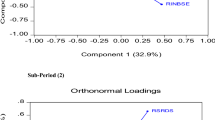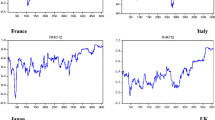Abstract
The purpose of this paper is to investigate Efficient Market Hypothesis (EMH) for Visegrad Group. The stock prices have been analyzed for the period between 1995 and 2014 with panel multiple structural breaks unit root test which is developed by Carrion-i-Silvestre et al. (2005). According to the findings, Efficient Market Hypothesis is accepted for Hungary, Poland, Czech and Slovak Republics (for all Visegrad Group). Stock prices have random walk. Due to the importance of monetary policy in equity markets the co-integration between interest rates and stock prices is also examined by the multiple structural breaks co-integration test which is developed by Basher and Westerlund (2009). This test considers the cross-section dependence between individual units. According to the test results; there is co-integration between interest rates and stock prices. Therefore, we could say that monetary policy decisions have an impact on investors’ behaviors.
Similar content being viewed by others
References
Ahmad A, Halim D, Siti NM, Azman-Saini WNW (2010) Efficient market hypothesis in emerging markets: panel data evidence with multiple breaks and cross sectional dependence. Econ Bull 30(4):2987–2995
Basher SA, Westerlund J (2009) Panel co-integration and the monetary exchange rate model. Econ Model 26:506–513
Brazova V-K, Matczak P, Takacs V (2013) Regional organization study: Visegrad Group. Analysis of civil security systems in Europe. Adam Mickiewicz University
Breusch TS, Pagan AR (1980) The Lagrange Multiplier test and its applications to model specification in econometrics. Rev Econ Stud 47(1):239–253
Carrion-i-Silvestre JL, Del Barrio-Castro T, Lopez-Bazo E (2005) Breaking the panels: an application to the GDP per capita. Econ J 8:159–175
Chaudhuri K, Wu Y (2003) Random walk versus breaking trend in stock process: evidence from emerging markets. J Bank Financ 27:575–592
Dockery E, Kavussanos MG (1996) Testing the efficient market hypothesis using panel data with application to the Athens stock market. Appl Econ Lett 3:121–123
Dong H, Helen BM, Latham WR (2013) Evidence on the efficient market hypothesis from 44 global financial markets. Econ Res Int. 2013:2–11
Fama EF (1970) Efficient capital markets: a review of theory and empirical work. J Financ 25(2):383–417
Fama EF (2013) Two pillars of asseting prices. http://www.nobelprize.org/nobel_prizes/economic-sciences/laureates/2013/famalecture.pdf. Accessed 03 June 2017
Ferreira N, Menezes R, Oliveria MM (2013) Structural breaks and co-integration analysis in the EU developed markets. Int J Latest Trends Financ Econ Sci 3(4):652–661
Ferreira N, Menezes R, Bentes S (2014) Cointegration and structural breaks in the EU sovereign debt crisis. Int J Latest Trends Financ Econ Sci 4(1):680–6890
Harris D, Leybourne S, McCabe B (2005) Panel stationary tests for purchasing power parity with cross-sectional dependence. J Bus Econ Stat 23:395–409
Im KS, Lee J, Tieslau M (2005) Panel LM unit root tests with level shifts. Oxf Bull Econ Stat 67:393–419
Kanas A (2001) Neural network linear forecasts for stock returns. Int J Financ Econ 6(3):245–254
Kumar A, Lee CMC (2006) Retail investor sentiment and return comovements. J Financ LXI(5):2451–2486
Kurov A (2010) Investor sentiment and the stock market’s reaction to monetary policy. J Bank Financ 34:139–149
Lee C-C, Lee J-D (2009) Energy prices, multiple structural breaks and efficient market hypothesis. Appl Energy 86:466–479
Lee C-C, Lee J-D, Lee C-C (2010) Stock prices and the efficient market hypothesis: evidence from a panel stationary test with structural breaks. Jap World Econ 22:49–58
Maddala GS, Wu S (1999) A comparative study of unit root tests with panel data and a new simple test. Oxf Bull Econ Stat 61:631–652
Narayan PK (2008) Do shocks to G7 stock prices have a permanent effect? Evidence from panel unit root tests with structural change. Math Comput Simul 77:369–373
Narayan PK, Smyth R (2005) Are OECD stock prices characterized by a random walk? Evidence from sequential trend break and panel data models. Appl Financ Econ 15(8):547–556.
Nelson CR, Plosser CL (1982) Trends and random walks in macroeconomics time series: some evidence and implications. J Monet Econ 10:139–162
Nguyen CV, Muhammad MA (2011) Testing the weak efficient market hypothesis using Bangladeshi panel data. Banks Banks Syst 4(1):11–15
Nguyen CV, Chang C-H, Nguyen TD (2012) Testing the weak-form efficient market hypothesis: using panel data from the Taiwan stock market. Int J Bus Soc Sci 3(18):192–198
Papell DH (2002) The great appreciation, the great depreciation, and the purchasing power parity hypothesis. J Int Econ 57:51–82
Pesaran HM (2004). General diagnostic tests for cross section dependence in panels. Working paper no: 0435. University of Cambridge, pp 1–39
Pesaran HM, Yamagata T (2008) Testing slope homogeneity in large panels. J Econ 142:50–93
Pesaran MH, Ullah A, Yamagata T (2008) A bias-adjusted LM test of error cross-section independence. Econ J 11(1):105–127.
Phillips PCB, Hansen BE (1990) Statistical inference in instrumental variables regression with I(1) processes. Rev Econ Stud 57(1):99–125.
Sharpe WF (1991) The arithmetic of active management. Financ Anal J 47:7–9
Author information
Authors and Affiliations
Corresponding author
Editor information
Editors and Affiliations
Rights and permissions
Copyright information
© 2018 Springer International Publishing AG
About this paper
Cite this paper
Saglam, Y., Guresci, G. (2018). A Random Walk of Stock Prices in Visegrad Group: Efficient Market Hypothesis. In: Dudycz, T., Osbert-Pociecha, G., Brycz, B. (eds) Efficiency in Business and Economics. Springer Proceedings in Business and Economics. Springer, Cham. https://doi.org/10.1007/978-3-319-68285-3_14
Download citation
DOI: https://doi.org/10.1007/978-3-319-68285-3_14
Published:
Publisher Name: Springer, Cham
Print ISBN: 978-3-319-68284-6
Online ISBN: 978-3-319-68285-3
eBook Packages: Economics and FinanceEconomics and Finance (R0)




